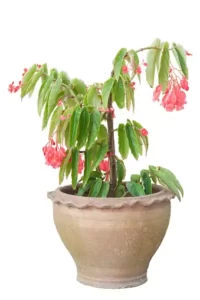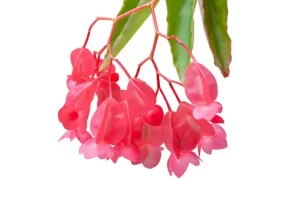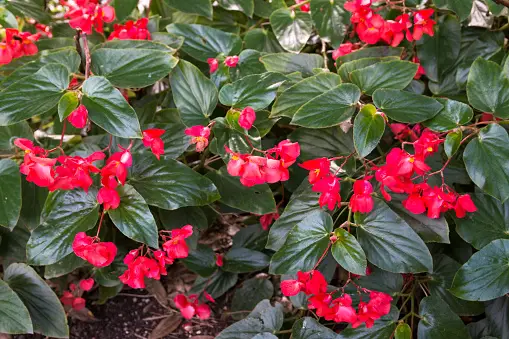Introduction
Wing begonias are a favorite among garden enthusiasts because of their magnificent blooms and unusual wing-shaped foliage. Whether you’re a seasoned gardener or a novice, mastering the art of wing begonia care is crucial to growing strong, bright plants. We will walk you through the essential stages and professional advice for growing and caring for wing begonias in this extensive guide.
Wing Begonia Care Guide
Wing begonias may flourish and add long-lasting beauty to your landscape with the right care. Spend some time admiring all of their distinctive features, from the delicate wing-shaped leaves to the breathtaking variety of hues and patterns in their blossoms. The satisfaction of successfully cultivating and caring for these begonias will undoubtedly be a reward for your efforts, whether you are an experienced gardener or a novice.
Selecting the Proper Location
The right site must be chosen for wing begonias care in order for them to flourish and thrive. These plants are perfect for regions with filtered sunlight or dark sections in your garden because they flourish in situations ranging from partial shade to full shade. They shouldn’t be exposed to direct sunlight because it will burn their fragile foliage.
Preparation of the Soil
Wing begonias must have correct soil preparation for them to thrive. They favor soil with good drainage and some moisture retention. To improve drainage and add important nutrients, start by adding organic matter to the soil, such as compost or peat moss. Wing begonias do well on soil that ranges from 5.5 to 6.5 on the pH scale.
Watering
Wing begonias require careful watering procedures. These plants abhor standing water and favor continually moist soil. When the top inch of soil seems dry to the touch, water them. Refrain from overwatering to prevent root rot. Mulching around the plants improves soil temperature control and moisture retention. The frequency of watering depends on various factors such as temperature, humidity, and the size of the pot. As a general rule, water your wing begonias when the top inch of soil feels dry. Avoid allowing the soil to completely dry out or become overly saturated.
Optimal Temperature Range
Wing begonias prefer a warm and stable temperature range between 60°F and 75°F (15°C – 24°C). They are sensitive to cold drafts and sudden temperature fluctuations, so it’s crucial to keep them away from doors and windows that may expose them to chilly air. If the temperature drops below 60°F (15°C), consider using a gentle heat source, such as a heating mat, to maintain the ideal temperature.
Fertilization
Your wing begonias will receive the nutrients they need for strong development and a profusion of flowers if you fertilize them frequently. A balanced, water-soluble fertilizer should be applied every two to four weeks from spring through fall. For the right dosage, follow the manufacturer’s recommendations. Be careful not to overfertilize as this might lead to lanky growth and decreased blossom yield.
Also Read: Crown of thorns houseplant
Pinching and Pruning
Wing begonias benefit from routine pruning and pinching to keep them compact, and a bushy shape. Pinch the stem tips off to promote branching and more rounded growth. To keep the plant looking good and healthy, remove any dead or yellowing leaves and discarded flowers. Pruning also enhances air circulation, which lowers the risk of illness.
Diseases and Pests
In the management of wing begonias, pest and disease surveillance is essential. Agonias are frequently harmed by aphids, mealybugs, and spider mites. Examine your plants frequently, and take the necessary steps to get rid of any infections. Keep an eye out for diseases like botrytis blight and powdery mildew. These fungi diseases can be avoided by avoiding overhead watering and maintaining good air circulation.
Propagation
Wing begonias may be multiplied, which is a great way to grow your collection. For propagation, stem cuttings are frequently employed. Remove the lowest leaves from a healthy stem cutting before dipping it in rooting hormone and placing it in a potting mix that drains well. Until the cutting form’s roots, give it enough warmth and humidity. Transplant the plant into a bigger container or the garden once the roots have taken hold.
Stem Cuttings: Take a 3-4 inch stem cutting from a healthy parent plant just below a leaf node. Remove the lower leaves, dip the cut end in the rooting hormone (optional), and place the cutting in a well-draining potting mix. Keep the soil moist and provide indirect light. Roots should develop in a few weeks, and you can transplant the new plant into its own pot once it has established roots.
Leaf Cuttings: Select a healthy leaf and cut it into sections, making sure each section has a visible vein. Lay the sections flat on a tray filled with a moistened substrate, such as perlite or vermiculite. Keep the tray in a warm and humid environment, ensuring the substrate remains moist. After a few weeks, tiny plantlets will emerge from the veins, and you can transfer them to individual pots.

Frequently Asked Questions (FAQs)
- Can I grow wing begonias outdoors?
Absolutely! Wing begonias can thrive both indoors and outdoors, provided they are protected from direct sunlight and extreme weather conditions.
- How often should I fertilize my wing begonias?
During the growing season, fertilize your wing begonias every two weeks with a balanced water-soluble fertilizer, diluted to half the recommended strength.
Do wing begonias require pruning?
Yes, regular pruning helps maintain the shape and vigor of wing begonias. Trim back leggy stems and remove spent flowers to promote bushier growth and continuous blooming.
What is the ideal humidity level for wing begonias?
Wing begonias prefer humidity levels around 50% to 60%. Increase humidity by using a humidifier, placing a tray filled with water near the plants, or grouping them together.
- How do I propagate wing begonias?
Wing begonias can be propagated through stem cuttings or leaf cuttings. Follow the respective techniques mentioned earlier in the article for successful propagation.
What should I do if my wing begonias are infested with pests?
If you notice pests such as aphids or spider mites, remove them by spraying the plants with water or using insecticidal soap. Introducing natural predators like ladybugs can also help control pest populations.
Conclusion
You may grow a thriving garden full of stunning, colorful begonias according to these crucial guidelines for wing begonia care. Don’t forget to give them the proper amount of shade, drained soil, and regular moisture. Their health will be preserved, and plentiful blossoming will be encouraged, with regular trimming, fertilizer, and insect control. Create a magnificent outdoor setting with these delightful plants by embracing the beauty and individuality of wing begonias. This is all about wing begonia care guide.
